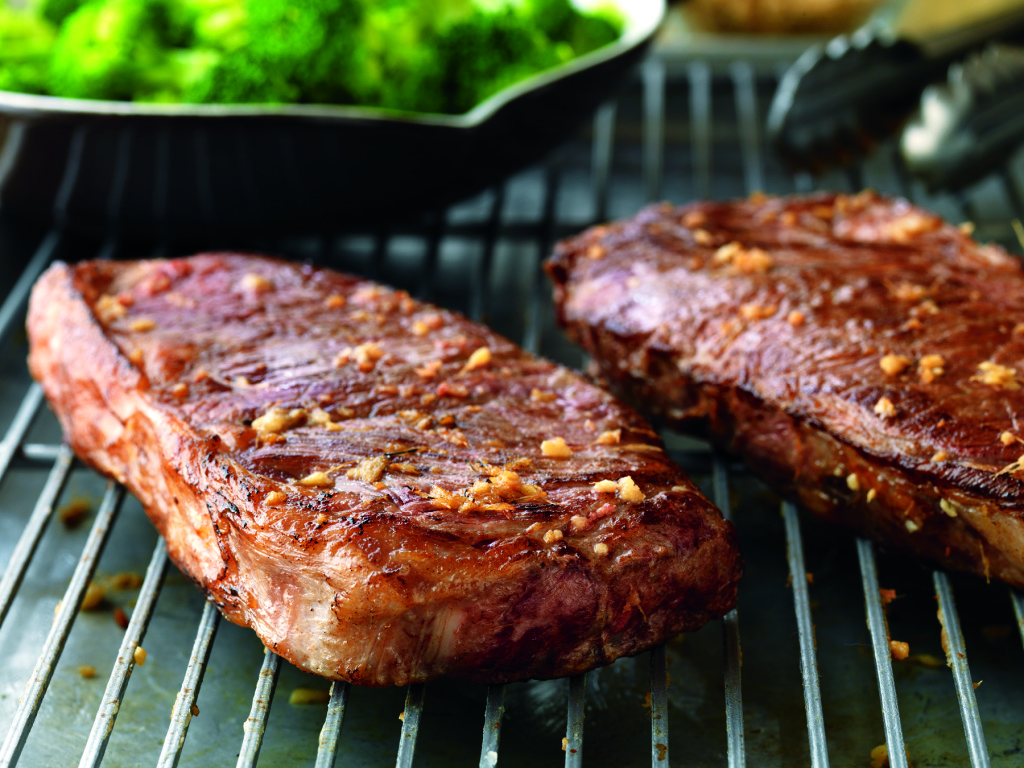How do you like your steak? Medium Rare? Medium? Well Done? The answer refers to the steak temperature. In this guide, we’ll talk about the different types of steak doneness and give you the only steak temperature chart you’ll ever need.

Why is steak temperature important?
A steak’s temperature tells the level of doneness for a steak. You’ve probably heard the terms rare, medium rare, medium, medium well, and well done before. Depending on your desired level of doneness, your steak needs to reach a specified internal temperature, which you can identify with a meat thermometer.
- Rare: 120-129°F
- Medium Rare: 130-134°F
- Medium 135-144°F
- Medium Well: 145-154°F
- Well Done: 155-164 °F
Contrary to what some may say, a steak’s doneness is not about the color or visual appearance of the beef. The color or visual appearance of beef is very subjective. Let’s say you order a steak and ask for it to be slightly pink in the center. Who decides what slightly pink is? You or the chef?
Plus, looking at it even more scientifically, external factors can change meat color such as the presence of nitrates, carbon monoxide and even certain vegetables. So, the only true way to know steak doneness is to take its temperature.
Steak Temperature Chart
Here’s the only chart you’ll ever need for steak temperature. As you’ll see, we’ve included a color and touch description, but we really didn’t want to! We’ve done it since it’s what so many people are accustomed to seeing. However, please use the temperatures, not the visual description!
Also, it’s critical to note that you need to pull your steak about 5-10 degrees BEFORE these final temperatures are reached.
So, if you’re wondering, why didn’t we publish a pull-temp chart, that’s a great question. Unfortunately, we can’t help you with a pull-temp chart. The reason for this is because pull-temps are extremely variable, and larger items experience more carryover than smaller.
In general, you can plan on 3–5°F of carryover for a thinner steak and anywhere from 5–10°F carryover for larger ones.
| Doneness | Temperature | Description |
| Rare | 120-129°F | Cool, bright red center; soft to the touch |
| Medium Rare | 130-134°F | Warm red center; beginning to firm up with red juices |
| Medium | 135-144°F | Warm pink center and outer portions beginning to brown; completely firm to the touch with red juices |
| Medium Well | 145-154°F | Slightly pink center; completely firm to the touch with brown juices |
| Well Done | 155-164 °F | No pink or red; firm to touch |
| Ground Beef | 160 °F | Fully brown throughout with no pink |
Note: The temperatures in this chart are final doneness. You need to pull your beef off the heat about 5-10°F before these temperatures are reached.
What is the Best Steak Temperature?
Rare – 120-129°F
Rare steak has cool-to-warm red center, and soft, tender texture. The USDA does not recommend eating rare meat, nor do many restaurants. However, if this is how you want to cook your steak, it’s an excellent choice for leaner steaks like top sirloin or filet mignon that don’t have as much fat to melt.
When cooking a steak to rare, it’s often seared on the outside at high temperatures (400°F) for a few minutes on each side. This results in a bright red center. When touched, the meat is soft and has almost no resistance to pressing with a finger.
Medium Rare – 130-134°F
To many people, a medium-rare steak is a perfect steak. It is the most popular level of doneness. Steaks served at this temperature are slightly warm, and have the best juiciness and texture. Medium-rare steaks are seared on the outside and the center has a dark pink red color. When touched, medium-rare steak gives only a slight resistance.
Medium – 135-144°F
A medium steak is also a very popular option. It has a pink center surrounded by brown meat. Medium steak meets the USDA’s recommended internal cooking temperature. A medium steak is completely warm and has no visible dark red in the center. Pressing on a medium steak with your finger gives slight resistance and it springs back a little.
Medium-Well 145-154°F
A medium-well steak will have a mostly brown center, with a faint pink color in the hot center. The meat will be much drier and chewier because the juices inside the steak will evaporate during the cooking process. If you press on it with your finger, it will be firm with a considerable amount of spring.
Well done -155-164°F
We don’t recommend cooking a well done steak because it becomes chewy and has very little flavor. At this level of doneness, the beef loses all of its natural juices and the steak shrinks. The color will be entirely brown with no pink. When touched, it will be firm and springy to the touch.
How to Take a Steak’s Temperature
Taking a steak’s temperature is easy with an instant-read meat thermometer (here’s our favorite). The beauty of most meat thermometers is that they’re extremely easy to use out of the box. You probably won’t need to read directions. However, the key to an accurate reading and knowing the internal temperature of the steak is to place the thermometer in the correct location in the beef, and that’s up to you.
Here are a few things you must keep in mind when taking the temperature of your steak:
- Location. Location. Location. When taking steak temps, measure in the thickest part of the steak or the center of the beef, not touching bone or fat. For steaks 1/2 inch or thicker, it’s usually best to insert an instant-read thermometer horizontally from the side.
- Remember carryover cooking. When you take a temperature reading of steak, you’re not always looking for the specific number in the chart above. Rather, you want to pull your steaks off when the thermometer reads 5-10°F lower than the desired doneness. In general, thicker cuts, like a rib eye steak or porterhouse steak, retain heat longer and need a longer resting time. Also, steaks cooked at high heat on a grill or a cast-iron skillet typically need longer resting time compared to steaks cooked at lower heat.
How to Rest Steak: Covered vs. Uncovered
When it comes to cooking a delicious steak, the process doesn’t end at taking the steak off the heat. Allowing the steak to rest after cooking is a crucial step that is often overlooked, but it’s essential for a juicy, tender and flavorful steak.
All cooked beef needs to rest before serving. The reason for this is because meat is a muscle with two main parts – protein and water. When steak is cooked, the muscle fibers contract because of the increased temperature. Then, the water is squeezed out of the fibers and the liquid moves towards the center of the steak.
Where and how the meat rests will also affect the carryover cooking. If the steak is removed from the heat source and placed on a cold surface, more heat will transfer into the room and less to the center of the meat. On the other hand, if it’s kept warm in the oven, the meat is likely to be overcooked.
Our recommendation is after your steak has reached your desire temperature, remove the steak from the heat source and place it on a warm plate, cutting board or serving platter. Next, tent the steak with aluminum foil. This will conserve some heat and still allow the air to circulate. Once you’ve tented the steak, that’s it. Don’t touch it or poke it or slice it. Let it rest for 5-7 minutes before you serve the steak.
Favorite Kitchen Tools:
One More Thing:
Do you want to learn more about beef? Join our weekly e-newsletter where we share farm happenings, recipes and beef availability. Sign-up and get a cheat sheet with 9-must-ask questions before buying beef directly from a farmer. Or, we have an entire ebook about beef that goes through purchasing and preparing beef from a cattle farmer’s perspective.
Here are a few other recipes and links you may like:
- Bacon wrapped filet mignon
- Easy garlic herb steak butter
- Dry rub or marinade for steak? Know what’s best
- Perfect Dry Rub for Roast
- Pepper Steak Stir Fry
- How to cook ground beef & easy recipes
- An Essential Guide to Beef ebook
We participate in the Amazon Services LLC Associates Program, an affiliate advertising program designed to provide a means for us to earn fees by linking to Amazon.com and affiliated sites. See our disclosure policy for more details.


You post interesting content here. Your page deserves much bigger audience.
It can go viral if you give it initial boost, i know very useful service that can help you, just
search in google: svetsern traffic tips